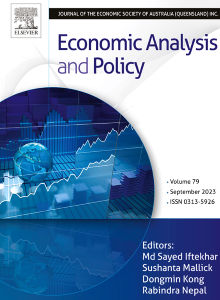Unleashing the digital dividend: Exploring how the digital economy promotes the construction of new urbanization in China’s 284 prefecture-level cities?
IF 7.9
2区 经济学
Q1 ECONOMICS
引用次数: 0
Abstract
In a “digital” era, developing the digital economy has become a key stepping stone for advancing new urbanization and common prosperity. This study explores the dynamic evolution characteristics of digital economy and new urbanization from the temporal-spatial dimensions through kernel density estimation (KDE). Spatial autocorrelation analysis and panel data spatial Durbin model (SDM) were used to empirically test the impact process, transmission path and spatial spillover effect of digital economy on new urbanization. In addition, the study further used the spatial distance threshold method and spatial difference-in-differences (SDID) to conduct detailed empirical tests on the heterogeneity of multi-distance thresholds, regional heterogeneity and robustness of the results of impact of digital economy on new urbanization. The study found that: (1) Digital economy and new urbanization both displayed a general growth tendency from 2011 to 2019, but both had significant temporal-spatial differences. (2) The improvement of digital economy not only supported local new urbanization efforts, but also generated positive spatial spillover effects on new urbanization in neighboring regions. (3) The spatial spillover of digital economy exhibited boundary and geographical attenuation characteristics effects on new urbanization, with spillover peaking at 800 km and attenuation reaching its limit at 1800km. (4) For regional heterogeneity, eastern region and urban agglomeration were more sufficient for the release of dividend and spillover spread of digital economy development. Technological innovation and industrial structure optimization were identified as crucial paths for transmission mechanism through which digital economy promote the construction of new urbanization. Therefore, to achieve regional coordination and common prosperity and further enhance spillover effects, efforts be made to integrate the digital economy with new urbanization, especially in central and western regions and non-central cities.
求助全文
约1分钟内获得全文
求助全文
来源期刊

Economic Analysis and Policy
ECONOMICS-
CiteScore
9.80
自引率
9.20%
发文量
231
审稿时长
93 days
期刊介绍:
Economic Analysis and Policy (established 1970) publishes articles from all branches of economics with a particular focus on research, theoretical and applied, which has strong policy relevance. The journal also publishes survey articles and empirical replications on key policy issues. Authors are expected to highlight the main insights in a non-technical introduction and in the conclusion.
 求助内容:
求助内容: 应助结果提醒方式:
应助结果提醒方式:


